We’re all aware of the effects of alcohol on our health; drinking in excess is going to cause serious health problems such as cancer, heart disease, and cirrhosis of the liver – just to name a few.
But a glass of red wine here and there is good for you, right? And it pairs so perfectly with a Mediterranean diet inspired meal.
Unfortunately, red wine isn’t as healthy as you may be giving it credit for. And while there may actually be some health benefits to drinking beer, there are way more reasons to stop drinking alcohol altogether.
But we don’t.
In fact, the “U.S. beverage market is a $354.2 billion industry with alcoholic beverages making 60% of the revenues with $211.6 billion in sales.”
So now that we’re all admitting to having a drink every now again (I’m raising my hand), let’s start talking about how to make smarter choices at the bar.
Thanks to websites such as Get Drunk, Not Fat, we have the power to truly analyze what’s going down when it’s bottom’s up.
There is No Healthy Alcohol
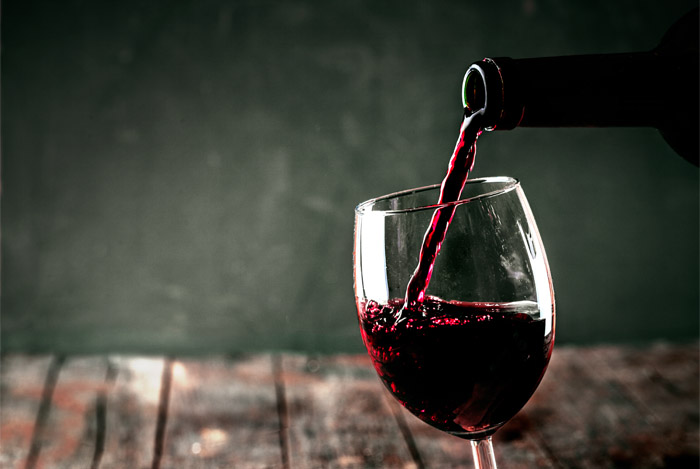 Let’s get this out of the way: I’m not telling you that the alcohol mentioned in this post is healthy.
Let’s get this out of the way: I’m not telling you that the alcohol mentioned in this post is healthy.
No alcohol is a healthy alcohol; alcohol is not healthy. I’ll need you to nod your head so I know you understand me.
All kidding aside, there’s zero nutritional value in alcohol. You’ll find no healthy protein, no complex carbs, and no essential fats in alcohol.
But you will find calories. Lots of them.
Now, I’m not not one for obsessively counting calories, but I like my calories to be justified.
For example, if I’m eating two eggs for 140 calories, I’m also gaining 12 g of protein and all the other amazing benefits that go along with eating super healthy eggs.
140 calories of alcohol will give me… nothing.
You can argue that drinks such as wine, cider, or beer at least come from whole foods such as grapes and apples. But let’s be honest here, how much of that actual fruit and fiber is present in your sugary beverage?
Not enough to justify the calories.
And even though these drinks may be “healthier”, it doesn’t give you free reign to drink five of them under the guise of good nutrition.
Remember: you’ll get the fewest calories, sugars, and health risks from the fewest drinks.
And always make sure you’re drinking a glass of water in between each drink you consume. This will not only make sure you’re processing your drinks at a safe pace, but it will also help avoid a hangover the following day.
“For every alcoholic drink you have, your body can expel up to four times as much liquid. The diuretic effect of alcohol and the dehydration it causes contribute to the discomfort of a hangover,” explains Jim Woodford, PhD, a forensic chemist specializing in drugs and alcohol.
Although if you do happen to find yourself in that gnarly predicament, we have some truly effective hangover methods you should always keep in your back pocket.
So now that we’ve cleared that up, let’s talk about the worst alcoholic drinks for your body and the best ones that work with your healthy lifestyle.
The Worst Drinks for Your Health
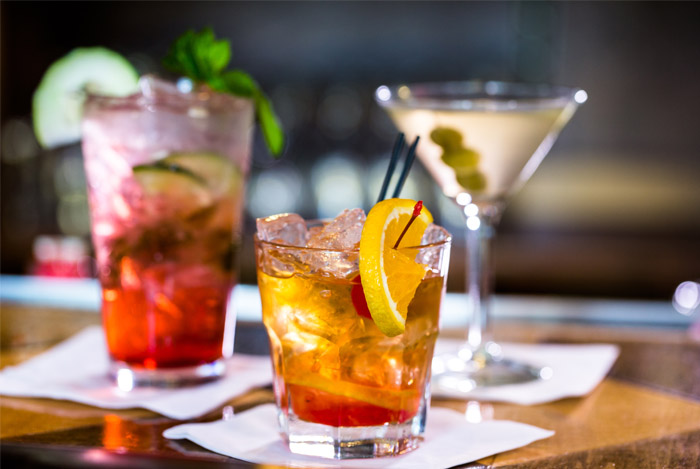
Hard alcohol has the fewest calories, so you would expect those beverages to be the ‘healthiest’ for you.
However, the real secret troublemaker at the bar is the mixers -aka, what ingredients go in a cocktail that make it something other than just alcohol – and they’ll easily become your downfall if you’re not careful.
I’ll tell you a secret: it’s all about sugar.
Mixed Drinks 101
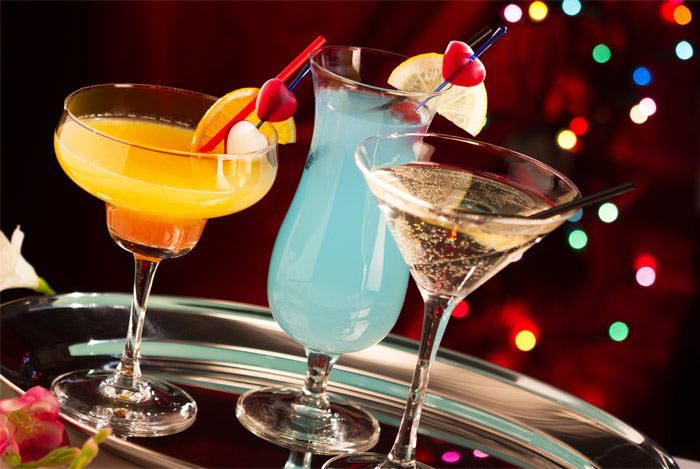 Our bodies consider alcohol a toxin and process it before anything else. Our body puts all other functions, such as maintaining our blood sugar levels, on the back burner, which is why “studies have shown that alcohol interferes with all three sources of glucose and the hormones needed to maintain healthy blood glucose levels.”
Our bodies consider alcohol a toxin and process it before anything else. Our body puts all other functions, such as maintaining our blood sugar levels, on the back burner, which is why “studies have shown that alcohol interferes with all three sources of glucose and the hormones needed to maintain healthy blood glucose levels.”
Drinking alcohol decreases the effectiveness of the insulin in your body, which means your blood sugar levels go haywire, leading to insulin resistance, and eventually type 2 diabetes.
According to one study: “45% to 70% of people with alcoholic liver disease had either glucose intolerance or diabetes.”
It’s no wonder why these two conditions go hand-in-hand. Adding sugary mixers to your alcoholic beverages is like adding fuel to the fire.
Does your bar have house mixes they make fresh daily with real ingredients, or do they use a bottle of mix that contains high fructose corn syrup and other harmful preservatives?
If you’re going to order a mixed drink, you need to know this.
“Cheap sour mixes are made from artificial lemon and lime flavoring along with corn syrup, coloring, preservatives, and stabilizers. Higher-end mixes are made with juice from concentrate, citric acid, and sugar.”
As you can see, a true no-win here as “high fructose corn syrup is the real driver of the current epidemic of heart attacks, strokes, cancer, dementia, and of course, type 2 diabetes,” and juice from concentrate isn’t any better or healthier.
Think about this: a 4 oz. serving of Margarita mix is 110 calories and 26 g of sugar before alcohol’s involved. With just one drink, you’re over your entire recommended sugar intake for the day!
Your body is completely overloaded with sugar because there’s no other macronutrients or fiber to slow it down, but it can’t do anything with all of it because it’s too busy processing the alcohol.
See the vicious cycle of events?
Don’t think you’re in the clear if you skip the mixer and opt for soda or juice – they work exactly the same.
Check out what these additions are costing you per 8 oz.:
- Coke: 97 calories; 27 g sugar
- Sprite: 100 calories; 26 g sugar
- Tonic water: 83 calories and 22 g of sugar.
- Cranberry juice: 137 calories; 30 g sugar
- Orange juice: 112 calories; 22 g sugar
Most people are surprised to learn that fruit juice isn’t that healthy and contains dangerous amounts of sugar.
With that being said, here are some of the worst offenders:
Amaretto Sour
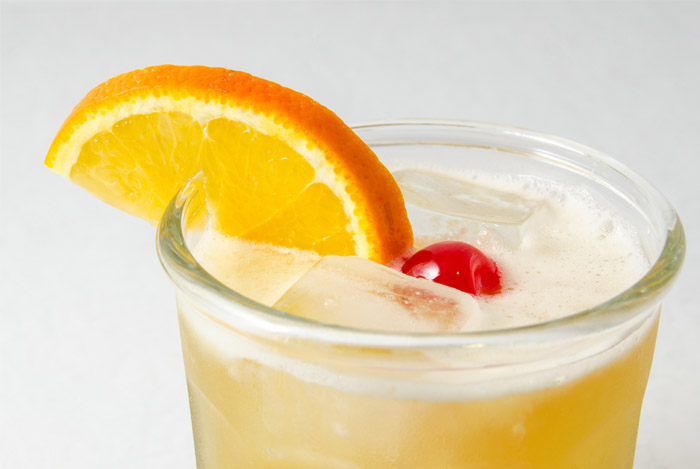 One of these may have more than 300 calories due to the commercially made sour mix. On top of that, it’s also loaded with sugar to the tune of 57 g per drink. No, you did not read that wrong.
One of these may have more than 300 calories due to the commercially made sour mix. On top of that, it’s also loaded with sugar to the tune of 57 g per drink. No, you did not read that wrong.
Long Island Iced Tea
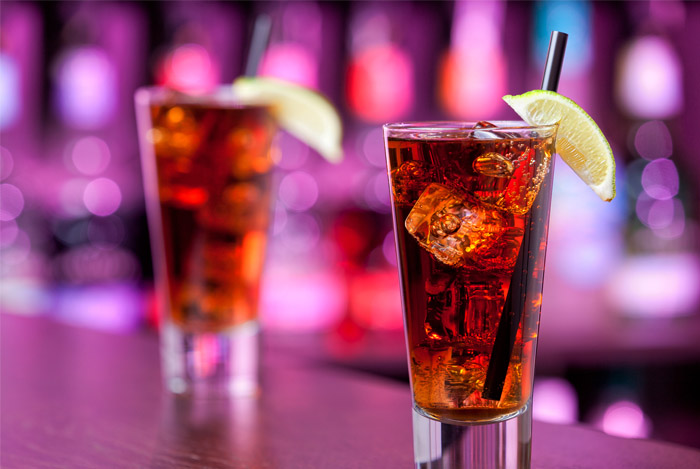 These drinks are larger than most cocktails, at a staggering 12 oz. or larger, so you’re already drinking more alcohol and sugar than you should be accounting for.
These drinks are larger than most cocktails, at a staggering 12 oz. or larger, so you’re already drinking more alcohol and sugar than you should be accounting for.
Here’s what’s in one of these disasters:
- Alcohol: vodka, rum, triple sec, gin, and tequila
- Mixers: sour mix and cola
Now do you see why these sometimes clock in around 529 calories?
Besides being overloaded with an unsafe (in my opinion) amount of alcohol, they also contain two of the worst mixers you can find behind the bar.
If you want to assume healthy bartender rockstar status, learn how to make your own sour mix and use half the sugar. You’re welcome.
Blended Frozen Drinks
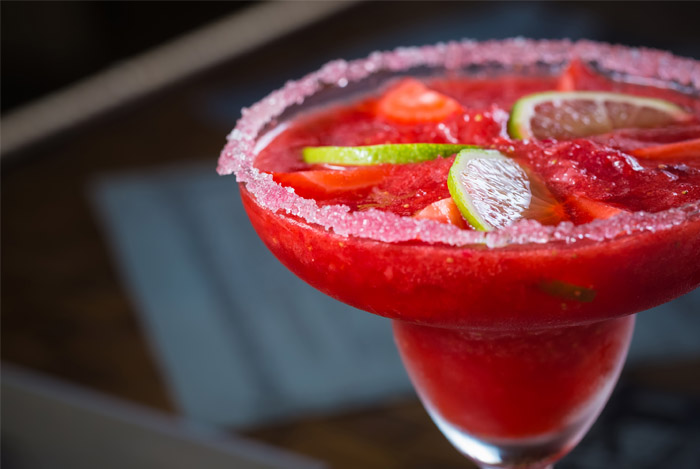 Daiquiris are a prime example of what happens when you mess with a good thing.
Daiquiris are a prime example of what happens when you mess with a good thing.
A traditional daiquiri calls for rum, lime juice, and a dash of simple syrup chilled and served in a cocktail glass. Easy and delicious, right?
But many bars think this is too complicated, so they buy ready-to-drink mixes and keep them in a spinning blending machine that churns out a HFCS-laden monster slush.
Those frozen single-serve daiquiri pouches at the grocery store are 280 calories and 36 g of sugar each! Frozen Margaritas or Pina Coladas at the bar can pack anywhere from 240–417 calories per drink.
Drinks that Taste Like Dessert
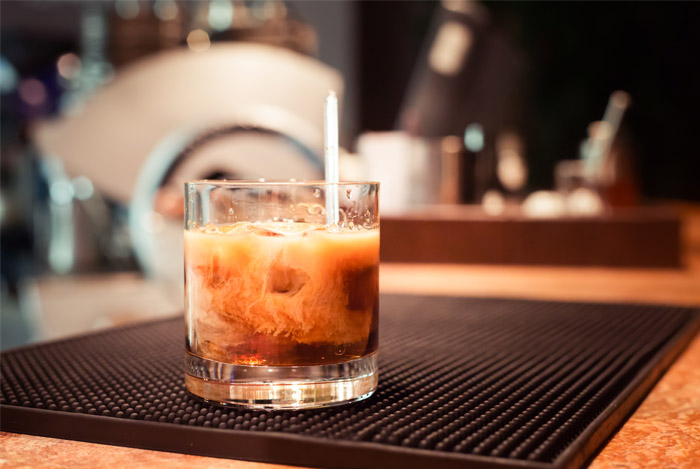 This category may be obvious to most people, but it’s worth having an explanation so you don’t get trapped by their tasty allure.
This category may be obvious to most people, but it’s worth having an explanation so you don’t get trapped by their tasty allure.
Just one White Russian will derail your diet by close to 300 calories thanks to the vodka, Kahlua, and cream – as in, the heavy cream that’s “the richest type of liquid cream with a fat content of at least 36%.”
Similarly, watch out for anything labeled as Irish cream as you’ll not only need to budget room in your diet for the sugar content, but also for the fat. A single shot glass-sized serving of this small after-dinner libation will set you back 147 calories, 9 g of sugar, and 6 g of fat.
Energy Drinks + Alcohol
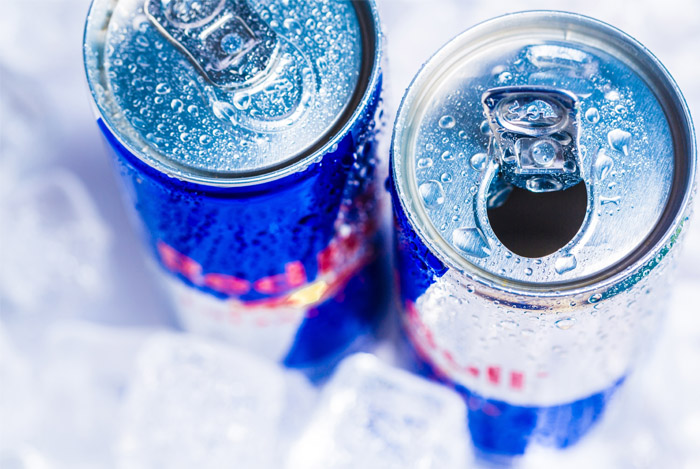 Though vodka Redbulls may have gotten you through college, you’re too smart to keep drinking these now.
Though vodka Redbulls may have gotten you through college, you’re too smart to keep drinking these now.
Mixing a stimulant like caffeine with a depressant such as alcohol is a pretty easy way to become intoxicated quickly, seriously ill, and both mentally and physically wiped out.
According to one study, drinking alcohol mixed with an energy drink is worse for you than drinking alcohol alone because the energy drink amplifies all of the alcohol’s effects. Scary stuff.
So there it is; the worst news is over. Now let’s get to those ‘healthier’ drinks I promised earlier.
Best Drinks for Your Health
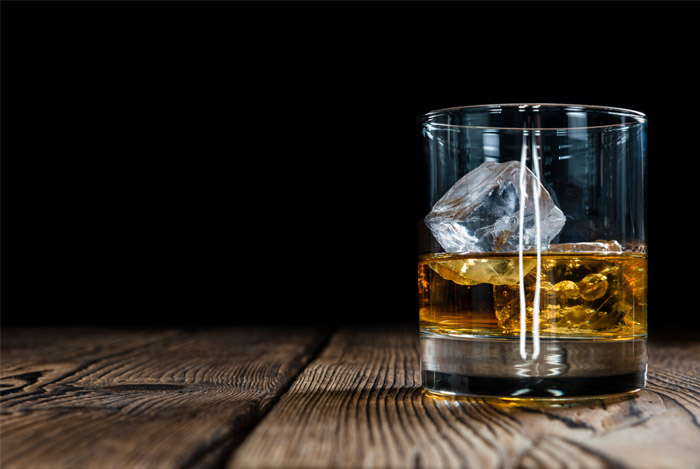 Since we’ve been talking about hard alcohol for most of this article, I feel like we should also discuss some of its more redeeming qualities to make up for all the negative (though well-deserved) attention.
Since we’ve been talking about hard alcohol for most of this article, I feel like we should also discuss some of its more redeeming qualities to make up for all the negative (though well-deserved) attention.
You can enjoy a ‘healthy’ cocktail with hard alcohol; some would even argue it’s the healthiest way to drink afterall.
Keep it Neat, Up, or On the Rocks
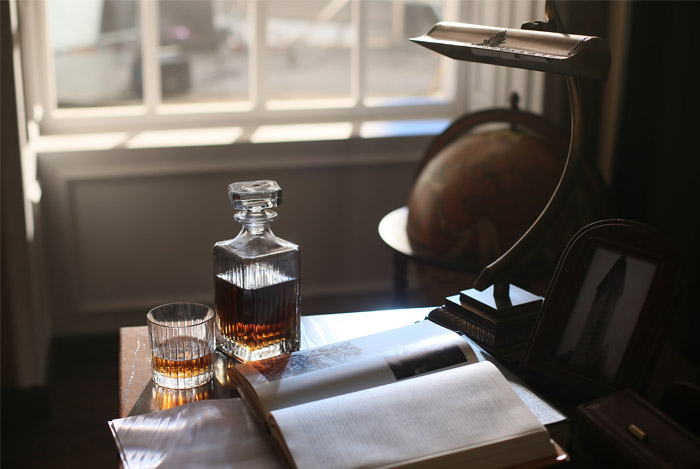 If you want the drink with the fewest possible calories and sugar at the bar, ask for your liquor with one of these adjectives.
If you want the drink with the fewest possible calories and sugar at the bar, ask for your liquor with one of these adjectives.
“Neat” means your bartender will pour just your alcohol of choice in a glass and serve it to you as is.
Ordering a drink “up” will result in a chilled serving of your alcohol selection.
And a drink “on the rocks” will be your of choice of alcohol over ice.
That’s it.
Now asking for these drinks may be straight up gutsy, so heed caution. Your alcohol won’t have any sweet mixers to tame the flame of high proofed alcohols.
In other words: prepare to feel the buzz sooner, especially since most hard alcohol is around 40% alcohol by volume.
But hang on a second. Unlike shots, neat and up drinks are meant to be sipped on. Think: slowly savoring an expensive whiskey or scotch with your pinky out.
This extra time will allow your body to process the alcohol at a much safer rate. Plus, you won’t have to deal with sugary fruit juice, high fructose corn syrup-laden mixers, or soda at all.
The only calories and sugars you need to account for are what’s in the alcohol itself, which are surprisingly low compared to the calorie-rich cocktails we’ve been discussing.
Here are a few examples of what those numbers look like per 1.5 oz serving:
- Vodka: 96–97 calories
- Tequila: 96–98 calories
- Rum: 81–98 calories
- Whiskey: 98–110 calories
- Gin: 96–116 calories
As you can see, you can have a cocktail that doesn’t bust your diet. But if you’re looking for a bit more oomph, you can try one of these:
Vodka and Seltzer / Club Soda
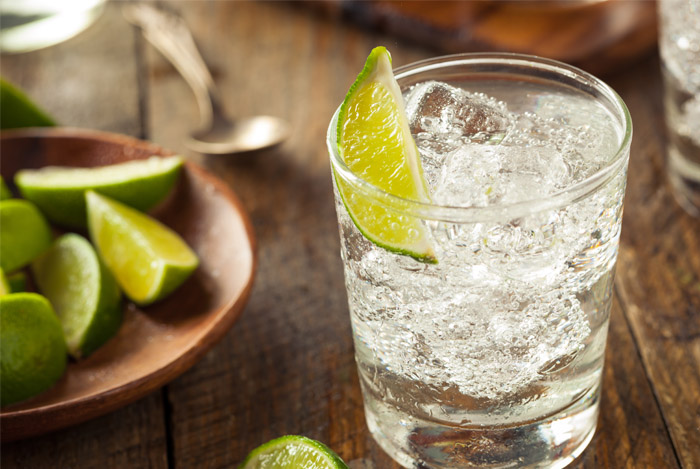 As you may have guessed, this drinks pulls no surprises; it’s just vodka and club soda (seltzer).
As you may have guessed, this drinks pulls no surprises; it’s just vodka and club soda (seltzer).
Club soda has zero calories, so the only calories you’re drinking come from your chosen vodka (around 96 calories).
You may perk up to know that the researchers from one study found that “vodka reduces stress more effectively than the alcohol-equivalent of red wine.”
So if you’re thinking of kicking back with a cocktail after work at happy hour, make it a vodka and soda.
If this is a bit too boring for you, you can add a lime, lemon, or orange wedge for some bright, citrusy flavor sans guilt.
Plus, according to one study, your immune system becomes weakened “within just 20 minutes of ingesting alcohol” so having that bit of vitamin C will really help you.
Manhattan
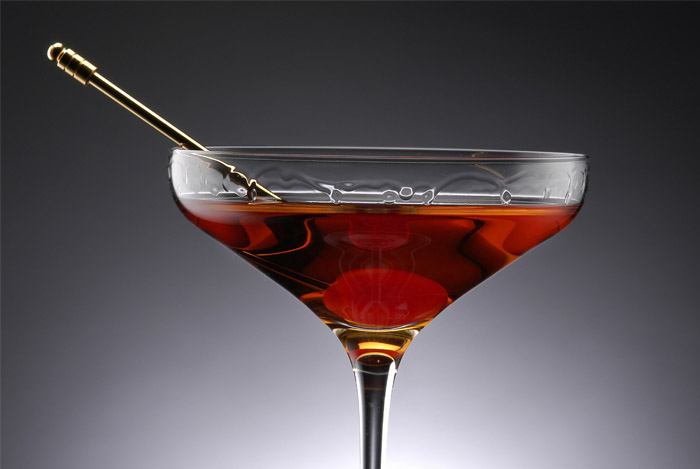 A surprisingly delicious drink, Manhattans are made with whiskey or bourbon, sweet vermouth, and Angostura bitters. This one’s well worth the 130 calories.
A surprisingly delicious drink, Manhattans are made with whiskey or bourbon, sweet vermouth, and Angostura bitters. This one’s well worth the 130 calories.
Vermouth is a type of fortified wine that gets its flavor from marrying hard liquor and macerated herbs for a few weeks.
Whiskey or bourbon is 40–50% ABV so you won’t need to drink many of these cocktails, either.
Plus, Angostura bitters are alleged to have restorative properties that can heal “sluggish digestion, poor appetite, or flatulence.”
Opt for Wine
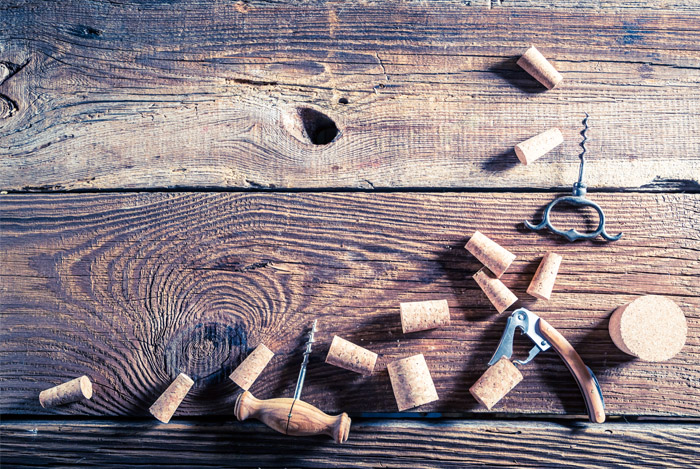 If you’re not looking to get crazy, a glass of wine will help you unwind and become a bit more social.
If you’re not looking to get crazy, a glass of wine will help you unwind and become a bit more social.
A glass of red wine will set you back about 120–150 calories. It’s about 14% ABV.
White wine is a bit better coming in at 100–150 calories, but it typically has a lower ABV of 12.5%.
There’s a common misconception that wine is high in sugar because it comes from fruit; however, the sugars are actually converted to alcohol during the fermentation process.
Dessert wines break this rule as they are higher in sugar (hence, sweeter).
Even though most people consider wine to be the healthiest alcoholic beverage, scientific results haven’t been conclusive enough to prove these myths as facts.
Beer Me
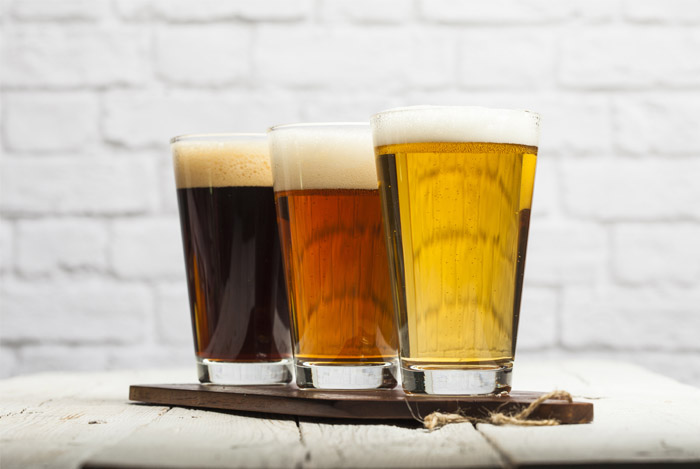 You have to be really careful with beer; depending on which beer you reach for, you could be sipping on 110 calories or 160. Big difference.
You have to be really careful with beer; depending on which beer you reach for, you could be sipping on 110 calories or 160. Big difference.
Another downside: beer isn’t as high in alcohol by volume (4–5%), so in order to get the same kind of buzz you would with liquor, you need to drink a lot of it. And all of those extra beers means a beer belly may not be far off in your future.
Beer’s also made of wheat and cereals so you’ll be upping your carb content, depending on each different type of beer:
Light lager: 95–110 calories; 5–6 g carbs
Lager: 135–150 calories; 5–12 g carbs
Ale: 160–175 calories; 13–19 g carbs
Stout: 128–171 calories; 9–11 g carbs
Cider: 125–200 calories; 10–22g carbs
While all of these seems like negatives, the scientific evidence points to several positives.
For instance, according to one study, moderate beer drinking was associated with a 31% reduced risk of suffering from heart attack, stroke, or heart disease.
And the hops in beer that give it that characteristically bitter taste contain acids that are incredible inflammation fighters.
During another study, men and women drinking moderate amounts of beer even reduced their risks of developing kidney stones by 41%.
So you may want to budget the extra calories and carbs to have a pint of beer every now and again.
Final Notes
 I’m not one for calorie trackers, but ReThinking Drinking has an awesome tool on their website for visualizing liquid calories.
I’m not one for calorie trackers, but ReThinking Drinking has an awesome tool on their website for visualizing liquid calories.
You’ll find calories listed next to each cocktail and all you need to do is enter the number of beverages you drink during the week so it can calculate an overall calorie total. Seeing this number may help you identify one of the reasons you’re not losing weight.
No matter which drinks you chose to imbibe, always make sure you do so in moderation. Any excessive drinking – even excessively drinking the healthier options we’ve discussed today – is still a surefire way to damage your health.
And if you want to see how bad alcohol really is for you, don’t forget to check out our article about the 9 amazing things that happen when you quit alcohol. They are truly eye-opening.
What’s your go-to adult beverage? Were you angry or happy to see your favorite drink on our list? Have any healthy cocktail hacks? Share all your thoughts with me in the comments— I’d love to hear what you think. Cheers!
The post Alcohol: The Best and the Worst Alcoholic Drinks for Your Health appeared first on Nutrition Secrets.
http://www.nutritionsecrets.com/best-and-worst-alcoholic-drinks-for-your-health/
No comments:
Post a Comment